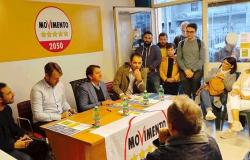
The national event “DI BORGO IN BORGO” starts this year, promoted by Archeoclub d’Italia to raise awareness among public opinion and the various institutions for an active and continuous promotion of the many places in Italy that are just waiting to be known in their beauty and environmental richness, but also for their history, culture and popular tradition.
Archeoclub INTEGRATED AREA OF THE STRETTO has chosen to raise awareness of San Filippo Superiore, a small hilltop village on the Peloritani ridge a few km from the city centre. One of the many places in Messina where history blends with nature, in the valley of the 40 mills, with the oldest dating back to 1200, and the San Filippo waterfall which has a 15 meter drop.
Sunday 21 April, from 9.30 am, visit the village of S. FILIPPO SUPERIORE whose name derives from Saint Philip of Agira.
A Sunday in the village – said Rosanna Trovato, President of the Archeoclub “Area Integrata dello Strait” – to make its beauty known and promote the richness of its environment, art and traditions.
The village of San Filippo Superiore has Roman origins. In that period the stream of the same name, the largest in the area, was navigable and was used to bring agricultural products downstream. From the Middle Ages to the mid-19th century there was a hegemony of the Basilian monastery, who enriched the area with the cultivation of cereals, figs and citrus fruits and, above all, through the sale of silkworms and already processed silk.
In 2017, by private individuals who had the desire to safeguard, protect and pass on the enormous cultural and agro-artisan heritage which, since ancient times, has characterized the San Filippo Valley, “The Museum of Grano” which today represents an important attraction that keeps alive the memory of the activity of the numerous water mills in the area and of the cultivation of wheat.
The purpose of the Museum, tells us Nino Bebba, soul and founder of this beautiful reality, is to document, testify, enrich, conserve, pass on and stimulate the new generations to know and appreciate the industrious and industrious history of that place, which made it the protagonist, in a decisive way, of a very important historical period for the socio-economic development of the territory.
A territory whose history is strongly linked to the presence of the Basilian Monks, settled in the convent of San Filippo the Great, built in 1100 around the cave where, according to tradition, San Filippo d’Agira lived for a short period, which determined the economic development of the population. In fact, it is also thanks to their entrepreneurial skills that they managed to transform the richness of the abundant waters of the valley into resources, building mills that were used to mill wheat for a vast territory whose borders went well beyond the province of Messina.
In recent years other volunteers in love with the village and its traditions have joined Nino Bebba in creating Thematic Areas in the alleys where, among mills and bagpipes, the ancient has a contemporary feel. The recovery of the mills is accompanied by the centuries-old tradition of bagpipes who have always accompanied grazing and transhumance with their music. A corner of the village is dedicated to the thematic ring of Ethnomusicology with the bagpipe and popular music instruments. Then, from door to door, wandering through the alleys we pass from agro-crafts, to beekeeping, to sericulture. And here is the thematic ring of sewing and embroidery, with the display of valuable artefacts, the fruit of a popular art which is slowly being lost.
All this has transformed the small village into a widespread museum and the memory archive of the Museum of Grain and Rural and Pastoral Culture of the ancient farmhouse of San Filippo Superiore will soon be inaugurated. Visiting the village is a dive into the past, tasting the flavors of the past and smelling ancient scents, in an area which, although a stone’s throw from the city, retains many vestiges of a thousand-year-old culture.
Two visits to the village are scheduled at 9.30 am and 11.00 am and a trekking excursion to the waterfall is scheduled starting at 9.30 am. Appointment in the terminal square of the ATM bus in San Filippo Superiore. Thanks to the active collaboration of the Volunteers of the San Filippo Grain Museum and of ARCHITREKKING coordinated by the Arch. Michele Palamara.

Tags: Messina Borgo Borgo event Archeoclub Integrated Area Strait San Filippo Superiore









